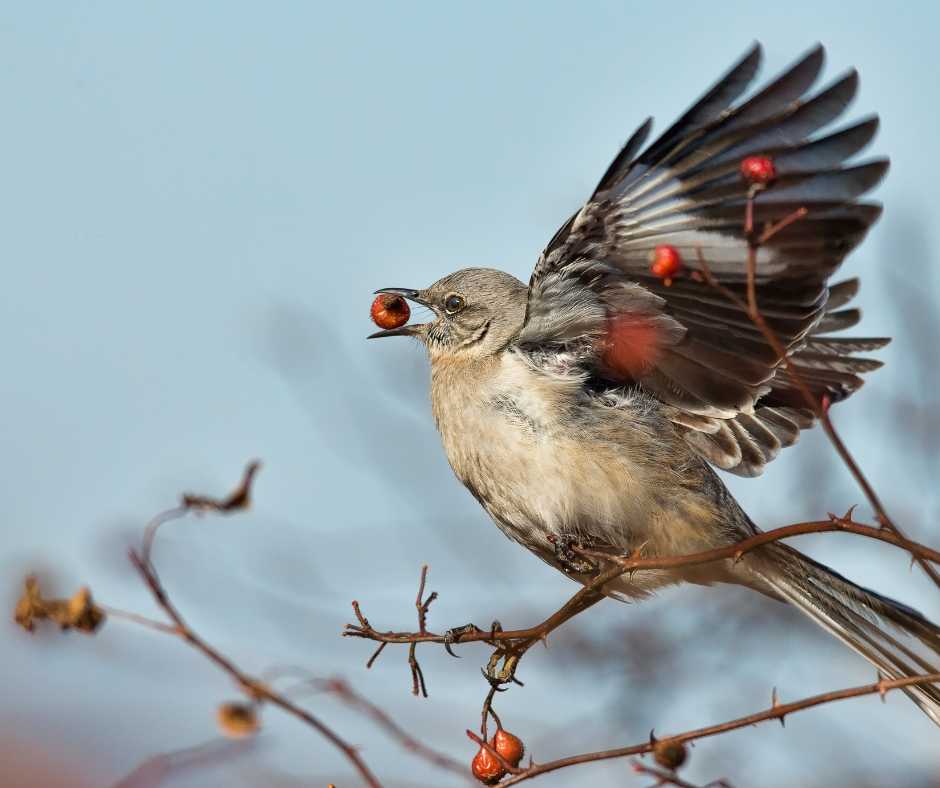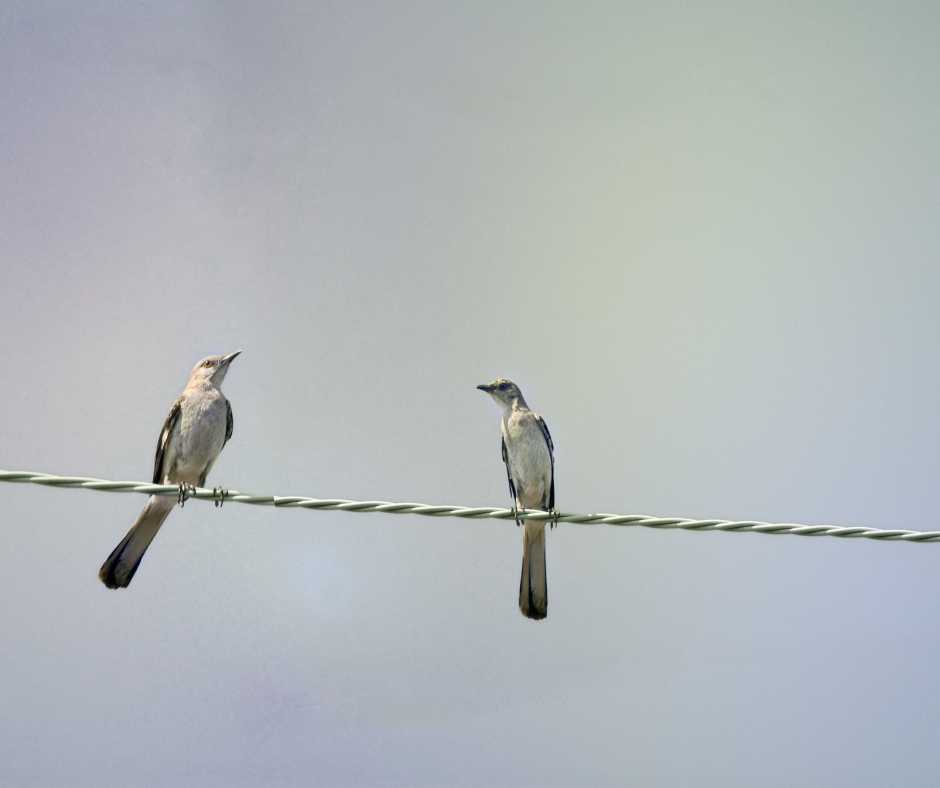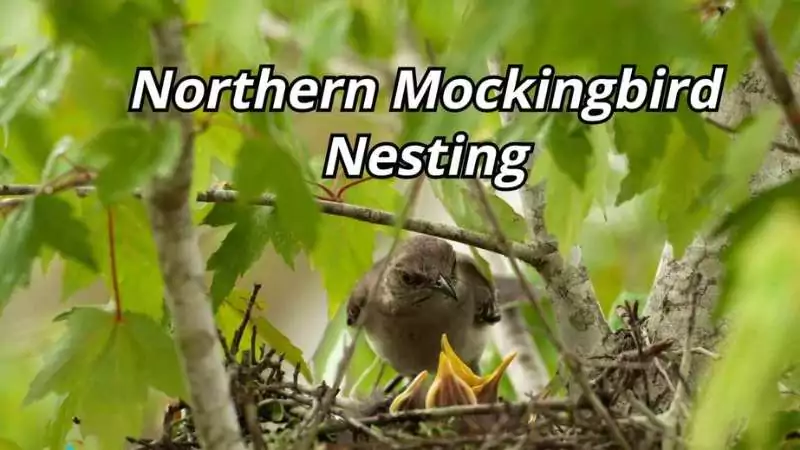We took a deep dive into the exciting world of northern mockingbird nesting and learned a lot! These birds are skilled at making their homes in parks and our backyards. They’re also very picky eaters, choosing just the right foods. All these cool facts show us how brutal and smart northern mockingbirds are.
But there’s a big reason we should care about all this. Learning about how these birds live and build their nests helps us love them even more. Plus, it shows us how important it is to keep their homes safe.
In this blog, we’re chatting about how we can protect the places where northern mockingbirds and other animals live. By looking out for them, we’re keeping the beautiful music of nature going vital for a long, long time. Get ready to learn about the fantastic world of northern mockingbird nesting and why we must help keep their homes safe.
| Aspect | Details |
| Habitat | Adapts to a wide range of environments, including urban parks, suburban gardens, and rural areas across North America. Prefers areas with dense shrubbery or thickets for protection. |
| Nest Location | Chooses sheltered spots within shrubs, trees, or on occasion, man-made structures. Locations are picked for their concealment from predators and elements. |
| Nest Appearance | Artfully constructed open cup made of twigs, grasses, and occasionally, urban debris like paper or strings. Designed for stability and insulation. |
| Nesting Phenology | Breeding season spans from late winter through early summer, peaking in spring. This timing aligns with the abundance of food sources for feeding offspring. |
| Nest Construction | Primarily the female’s task, involving meticulous assembly of materials over several days. Both males and females gather construction materials. |
| Egg Characteristics | Clutch typically consists of 2-6 pale blue or greenish eggs, speckled with brown. Eggs are laid daily until the clutch is complete. |
| Fledgling Development | Chicks fledge about 12 days post-hatching but remain near the nest, receiving parental care and learning to forage for several weeks. |
| Parental Care | Both parents are involved in feeding and defending the chicks. The male often supports by guarding the territory and feeding the female during incubation. |
| Conservation Status | While generally stable, local populations can be impacted by habitat loss and pesticide use. Conservation efforts focus on preserving natural habitats. |
| Observation Tips | Best observed in early morning or late afternoon when they are most active. Use a quiet, non-intrusive approach to avoid disturbing them. |
Habitat and Nest Location
The Northern Mockingbird, a master of melody and mimicry, thrives in places you might pass by daily. Have you ever wondered where these talented singers hang their hats? Well, let’s dive into their home-making secrets!
Where Do Northern Mockingbirds Nest?
Imagine a cozy nook in a bustling park or your serene garden; that’s where you’d likely find a Northern Mockingbird’s nest. These birds are the ultimate adaptors, making homes in open areas dotted with welcoming bushes or trees. They’re not too fussy about the postcode as long as there’s a bit of greenery and peace.
Do Northern Mockingbirds Nest in the Same Place Every Year?
Think of Northern Mockingbirds as explorers, always looking for the next best thing. They stick to something other than last year’s nesting site. Instead, they scout new locations each season, seeking the perfect blend of safety and nearby snacks. It’s all about upgrading their nest’s neighborhood!
Do Northern Mockingbirds Nest in Backyards?
Absolutely! Your backyard could be the prime real estate they’re looking for. If you’ve got shrubs or small trees, congratulations, you’re potentially on a Mockingbird’s housing list. These birds appreciate a good backyard setup where they can sing their hearts out and raise their young.
Do Northern Mockingbirds Use Nest Boxes?
Northern Mockingbirds like living in natural spots but might use a nest box if it’s hidden, safe, and cozy. Still, they usually like to make their nests in places they’ve picked out, ensuring the nest is safe and comfy.
What Trees Do Northern Mockingbirds Nest In?
From the whispering pines to the sturdy oaks, Northern Mockingbirds aren’t picky tenants. They value safety over species, often choosing trees or shrubs with thick, protective branches. It’s all about keeping their nestlings safe from prying eyes and eager predators.
How High Are Northern Mockingbird Nests?
These nests usually perch between 3 to 10 feet off the ground, not too high but just enough to survey their surroundings and ward off any threats. This height gives them a bird’s-eye view (pun intended) of any approaching danger while keeping their precious brood out of reach.

So, there you have it—a glimpse into the life and times of the Northern Mockingbird’s nesting habits. These birds are about location, safety, and the perfect backdrop for their next concert. You might hear their song in a bustling park or your tranquil backyard if you listen closely.
Nest Appearance and Construction
Diving into the world of Northern Mockingbirds, let’s unwrap the mysteries of their homes—those snug, cozy nests that dot our neighborhoods and wild spaces alike. Have you ever peeked into one? Here’s the scoop on what makes a mockingbird’s nest so unique.
What Do Northern Mockingbird Nests Look Like?
Imagine a tiny, substantial bowl carefully tucked into tree branches. Northern Mockingbirds are the nest-making experts of the bird world. They use sticks, grass, and leaves to build their nests. All these pieces fit together to make a cozy, safe home for their baby birds.
How Big Are Northern Mockingbird Nests?
Imagine holding a softball in your hands—that’s about the size of a mockingbird’s nest. It’s big enough to cradle a clutch of eggs and keep them warm, yet compact enough to hide away from prying eyes and predators. It’s just the right size for a family starting out.
How Do Northern Mockingbirds Build Their Nests?
At the start, gathering materials is a team effort, with mom and dad mockingbirds diving in. But the female takes the reins when nest building gets down to the nitty-gritty. Over several days, she meticulously assembles these materials into a nest, shaping and reshaping until it’s perfect.
What Do Northern Mockingbirds Use for Nesting?
From the natural to the manufactured, mockingbirds aren’t picky. Twigs, leaves, and grass comprise the bulk of their building materials, providing structure and comfort. But don’t be surprised to find bits of plastic, string, or even snippets of paper woven into the mix. These birds are masters of recycling, turning whatever they find into a cozy abode.
Do Male or Female Northern Mockingbirds Build the Nest?
While it’s initially a joint effort, the female mockingbird is the true architect of the nest. Her partner supports her by supplying materials, but she’s the one who puts it all together, ensuring every twig and leaf is perfectly placed. It’s her touch that turns a pile of debris into a haven for her chicks.
In the bustling life of a northern mockingbird, their nests stand as testaments to resilience, ingenuity, and the care they invest in the next generation. Next time you spot one of these nests, take a moment to appreciate the effort and love woven into every fiber.
Northern Mockingbird Eggs and Brooding
In the world of Northern Mockingbirds, the start of a new life is as delicate and beautiful as a piece of art. Let’s dive a little deeper into the journey from eggs to the first flight of these charming birds.
What Do Northern Mockingbird Eggs Look Like?
Imagine a small, smooth canvas painted in the softest shades of pale blue or greenish, each uniquely speckled with brown spots. Nestled together, these eggs look like tiny masterpieces waiting to reveal the life they hold inside. Nature sure knows how to create beauty in the smallest packages!
How Many Eggs Do Northern Mockingbirds Lay?
A Northern Mockingbird mama lays about 2 to 6 eggs per clutch, setting the stage for a snug little family. The nest is relatively quiet, ensuring each future fledgling gets the care and attention it needs to thrive. Think of it as the bird version of a cozy, loving home where each member is cherished.
How Long Does It Take for Mockingbird Eggs to Hatch?
After the eggs are laid, a waiting period lasts about 12 to 13 days. During this time, the mother keeps her precious eggs warm, turning them gently to ensure each gets an even share of her warmth. It’s a waiting game filled with anticipation for the chirping life soon to emerge.
Do Male Northern Mockingbirds Sit on Eggs?
While the mother bird keeps the eggs warm, the father Northern Mockingbird isn’t just hanging out. He’s working hard to protect their home and find food, ensuring his mate and future babies are safe. Working together is vital in their world, and parents do essential jobs to help their little ones grow up strong.
Do Mockingbirds Lay Eggs in Other Birds’ Nests? (A Myth Debunked)
There’s a tall tale that mockingbirds are the freeloaders of the bird world, laying their eggs in the nests of others. But let’s set the record straight: that’s a myth. Northern Mockingbirds are dedicated homemakers, building and maintaining their nests for their eggs and chicks. They put in the work, just like any good parent should.

From the pretty eggs to both parents caring for them, the story of how Northern Mockingbirds grow up is fascinating. Each egg, each day they wait, and everything the parents do help create the fantastic story of life we see in our yards and parks.
Fledgling and Parental Care
Life starts buzzing with activity from the get-go in the cozy world of Northern Mockingbird nests. Let’s peek into their nest life and parental care, shedding light on these diligent birds’ family dynamics.
How Long Do Mockingbirds Stay in the Nest?
Mockingbird chicks, snug in their nest, spend about 12 adventurous days under the watchful eyes of their parents before they’re ready to flap their wings. These first days are crucial as they learn the ropes of bird life from the safety of their nest.
How Many Broods Do Northern Mockingbirds Have?
Talk about a whole house! Northern Mockingbirds are devoted parents, managing to raise two to three broods each year. This means they’re almost constantly in parenting mode during the breeding season, from finding food to teaching their young.
When we look at how Northern Mockingbirds live, we can see they work hard to care for their babies. They spend busy days in their nests, and both mom and dad help feed their little ones. These birds show us how much parents in the bird world do for their families.
Feeding Habits
What Do Northern Mockingbirds Eat?
Northern Mockingbirds have quite the palate, switching between insects and fruits through the seasons. Summer sees them hunting down beetles, ants, and spiders, making them natural pest controllers. When winter rolls in, they switch to fruits and berries, helping to disperse seeds far and wide. This diverse diet ensures they’re always well-fed, no matter the season.
Do Both Northern Mockingbird Parents Feed the Chicks?
Absolutely! In the Mockingbird world, parenting is a team effort. Both mom and dad take turns bringing food back to the nest, ensuring their chicks get a varied diet. This tag-team approach helps their young grow strong and ready for the world outside their nest.

Migratory Patterns and Behavior
Do Northern Mockingbirds Migrate?
While Northern Mockingbirds are mostly year-round residents of their territories, they show a bit of wanderlust under certain conditions. Some might move to warmer areas when the cold bites too hard, but these trips are more like short vacations than permanent moves. So, if you notice fewer mockingbirds in winter, don’t worry—they’re just off-catching some sun.
Do Mockingbirds Mate for Life?
Romance for Northern Mockingbirds is more seasonal than lifelong. They pair up for the breeding season, sharing duties from nest-building to feeding their young. But once the season ends, so does their partnership, ready to start anew next year. It’s all about practicality and ensuring the next generation thrives.

People Also Asked
When Do Northern Mockingbirds Mate and Nest?
Northern Mockingbirds get busy with their love lives in the spring, from late February through August. It is their prime time for setting up nests and starting families. They’re all about the warm vibes, choosing this season to mate and lay eggs when food is plentiful, and temperatures are just right.
Where Do Northern Mockingbirds Nest at Night?
When the sun dips down, Northern Mockingbirds head back to their nests, tucked away in trees or shrubs. These night-time retreats offer safety and warmth for resting. Like us, they prefer a cozy, secure spot to catch some Z’s after a long day of foraging and singing.
How to Attract Nesting Northern Mockingbirds?
Want to roll out the welcome mat for these songbirds? Start with planting native shrubs and small trees in your garden. They love areas resembling their natural habitat—dense foliage for shelter and a mix of fruiting plants for snacks. A water source, like a birdbath, and avoiding pesticides will make your yard a mockingbird paradise.
How Big Is a Northern Mockingbird?
Northern Mockingbirds are medium-sized songbirds, stretching about 9 to 11 inches from beak to tail. Their wingspan can reach up to 14 inches, making them quite present in the garden. Despite their modest size, their bold personality and melodious tunes make them stand out in the bird world.
Wrap Up
Exploring the nesting world of northern mockingbirds has shown us how unique and challenging these singing birds are. They eat all sorts of food, build their nests in cool ways, and we’ve even busted some myths about them! It’s super important to keep their homes safe. Doing this helps their beautiful songs stay around for kids and grandkids to hear, holding their places safe and sound.
So, let’s remember we all have a part in taking care of where northern mockingbirds and lots of other animals live. Let’s make sure the beautiful sounds of nature keep going strong.
Further Reading:
1. Cornell Lab of Ornithology – All About Birds: Northern Mockingbird Profile
This resource provides comprehensive details on the Northern Mockingbird, including its habitat, diet, nesting habits, and vocalizations, supported by the authority of the Cornell Lab of Ornithology.
2. Audubon Guide to North American Birds: Northern Mockingbird
The National Audubon Society offers an in-depth look at the Northern Mockingbird, focusing on identification, behavior, and conservation status, enriched with high-quality images and bird calls.
3. BirdLife International: Northern Mockingbird Conservation Status
BirdLife International provides the latest research and conservation status on the Northern Mockingbird, including threats and actions needed to protect this species globally.
4. Birds & Blooms: How to Identify a Northern Mockingbird
This article provides detailed insights into the Northern Mockingbird, including its distinctive traits and habits, alongside tips for attracting them to your garden with native plants and water features.

